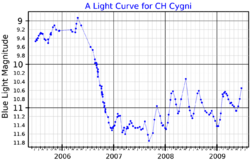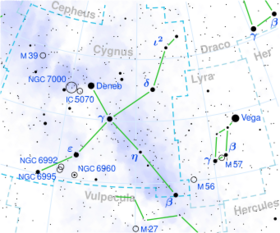Astronomy:CH Cygni
| Observation data Equinox J2000.0]] (ICRS) | |
|---|---|
| Constellation | Cygnus |
| Right ascension | 19h 24m 33.06773s[1] |
| Declination | +50° 14′ 29.1263″[1] |
| Apparent magnitude (V) | 5.60 – 8.49[2] |
| Characteristics | |
| Spectral type | M7IIIab + Be[3] |
| Variable type | Z And and SR[2] |
| Astrometry | |
| Radial velocity (Rv) | −59.74[4] km/s |
| Proper motion (μ) | RA: −7.09[1] mas/yr Dec.: −59.74[1] mas/yr |
| Parallax (π) | 5.4642 ± 0.2172[5] mas |
| Distance | 600 ± 20 ly (183 ± 7 pc) |
| Orbit[6] | |
| Period (P) | 15.58±0.13 yr |
| Semi-major axis (a) | 8.5 astronomical unit|AU |
| Eccentricity (e) | 0.122±0.024 |
| Inclination (i) | 84° |
| Semi-amplitude (K1) (primary) | 4.45±0.12 km/s |
| Details[6] | |
| Red giant | |
| Mass | 2 M☉ |
| Radius | 280 R☉ |
| Luminosity | 5012 L☉ |
| Temperature | 3,100 K |
| White dwarf | |
| Mass | 0.7 M☉ |
| Luminosity | 0.25 L☉ |
| Other designations | |
| Database references | |
| SIMBAD | data |
CH Cygni (CH Cyg / HIP 95413 / BD +49 2999) is a red giant, variable, symbiotic binary in the constellation Cygnus. It is the nearest symbiotic star to Earth, and one of the brightest, making it an ideal candidate for study.
Properties
CH Cygni has a mass of 2 M☉ and a radius of 280 R☉. Its white-dwarf companion has a mass of 0.75 M☉, and the orbital period of the two stars is 5689 days.[6] CH Cygni is classified as M7IIIab + Be.[3]
Observation history

The earliest observations of CH Cygni were made in 1890 by Pickering and Wendel using wedge photometer, and was classified as a M6III variable star in 1924.[8] In 1963 strong H I emissions were observed, indicating CH Cygni was likely in a symbiotic relationship with a white dwarf. Similar emissions were observed in 1965, 1967, 1977, 1992, and 1998.[9] The system was briefly thought to contain a third star[10] but this was later disproved.[6]
In 1984 bipolar jets were detected coming from CH Cygni, which were suspected to be due to accretion from its companion star.[9][8] The luminosity of the system decreased significantly in 1986, likely owing to dust thrown out of the system by the jets or a concurrent helium flash. This dust had dissipated by 2002, with subsequent luminosities returning to pre-1985 levels.[3]
References
- ↑ 1.0 1.1 1.2 1.3 van Leeuwen, F. (13 August 2007). "Validation of the new Hipparcos reduction". Astronomy & Astrophysics 474 (2): 653–664. doi:10.1051/0004-6361:20078357. Bibcode: 2007A&A...474..653V.
- ↑ 2.0 2.1 Samus, N. N. et al. (2009). "VizieR Online Data Catalog: General Catalogue of Variable Stars (Samus+ 2007-2013)". VizieR On-line Data Catalog: B/GCVS. Originally Published in: 2009yCat....102025S 1. Bibcode: 2009yCat....102025S.
- ↑ Famaey, B.; Pourbaix, D.; Frankowski, A.; Van Eck, S.; Mayor, M.; Udry, S.; Jorissen, A. (18 February 2009). "Spectroscopic binaries among Hipparcos M giants". Astronomy & Astrophysics 498 (2): 627–640. doi:10.1051/0004-6361/200810698. Bibcode: 2009A&A...498..627F.
- ↑ Brown, A. G. A. (August 2018). "Gaia Data Release 2: Summary of the contents and survey properties". Astronomy & Astrophysics 616: A1. doi:10.1051/0004-6361/201833051. Bibcode: 2018A&A...616A...1G.
- ↑ 6.0 6.1 6.2 6.3 Hinkle, Kenneth H; Fekel, Francis C; Joyce, Richard R (2009). "Infrared Spectroscopy of Symbiotic Stars. Vii. Binary Orbit and Long Secondary Period Variability of Ch Cygni". The Astrophysical Journal 692 (2): 1360. doi:10.1088/0004-637X/692/2/1360. Bibcode: 2009ApJ...692.1360H.
- ↑ Wallerstein, George; Munari, U.; Siviero, A.; Dallaporta, S.; Dalmeri, I. (January 2010). "The Spectrum and Light Curve of CH Cygni during its Recent Broad Minimum". Publications of the Astronomical Society of the Pacific 122 (887): 12–16. doi:10.1086/648563. Bibcode: 2010PASP..122...12W.
- ↑ 8.0 8.1 Mikołajewski, M.; Mikołajewska, J.; Khudiakova, T.N. (August 1990). "A long-period symbiotic binary CH Cygni. I - A hundred years' history of variability". Astronomy and Astrophysics 235 (1–2): 219–233. ISSN 0004-6361. Bibcode: 1990A&A...235..219M.
- ↑ 9.0 9.1 Burmeister, M.; Leedjärv, L. (9 July 2009). "Spectroscopy of the symbiotic binary CH Cygni from 1996 to 2007". Astronomy & Astrophysics 504 (1): 171–180. doi:10.1051/0004-6361/200911686. Bibcode: 2009A&A...504..171B.
- ↑ Hinkle, Kenneth H.; Fekel, Francis C.; Johnson, Diana S.; Scharlach, Werner W. G. (March 1993). "The triple symbiotic system CH Cygni". The Astronomical Journal 105: 1074. doi:10.1086/116494. Bibcode: 1993AJ....105.1074H.
 |


